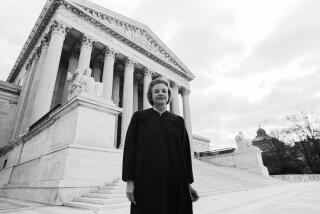Faith in Huston’s ‘Wise Blood’
- Share via
For the most part, Christian cinema, from the refined sublimity of Robert Bresson to the literal-minded gore of Mel Gibson, has been the province of believers. But in the case of “Wise Blood,” John Huston’s long-overlooked 1979 adaptation of a Flannery O’Connor novel, an interesting tension arises from the seeming contradiction of an atheist adapting a Christian allegory by a deeply Catholic writer -- and doing it, so to speak, faithfully.
New to DVD this week from the Criterion Collection, “Wise Blood” follows the spiritual crisis of one Hazel Motes (Brad Dourif), an Army veteran newly returned to his hometown in the Bible Belt. (O’Connor set her novel, published in 1952, in the fictional town of Taulkinham, Tenn.; the film was shot in Georgia.)
Angry, intense and apparently plagued by memories of a hellfire-spewing preacher grandfather (played in flashbacks by Huston himself), Hazel rejects the deep-seated religiosity of his upbringing and establishes his own creed. He calls it the Church of Christ Without Christ, “where the blind don’t see and the lame don’t walk and what’s dead stays that way.”
Preaching his nihilistic gospel on street corners and atop the hood of his cherished old automobile, Hazel encounters a host of cretinous crackpots, including a fellow sidewalk preacher and shameless charlatan (Harry Dean Stanton) and his nymphet of a daughter (Amy Wright), who soon becomes Hazel’s lover.
Apart from a manic young simpleton (Daniel Shor) who finds a “new Jesus” for Hazel in the form of a shriveled mummy, the Church of Christ Without Christ does not catch on right away. But an evangelical promoter (Ned Beatty) sees moneymaking potential in the idea and hires a look-alike surrogate (William Hickey) to compete with Hazel. Hazel’s confrontation with this false prophet sets the tormented hero on his path toward a particularly violent brand of redemption.
“Wise Blood” was the first of O’Connor’s two novels, and Huston’s movie is the only feature film to have been made from any of her works. Huston was approached by producers Michael and Kathy Fitzgerald, children of Robert Fitzgerald, the poet and translator who was O’Connor’s literary executor. The Fitzgeralds were close friends of O’Connor’s, and the movie, notwithstanding Huston’s involvement, was something of a family affair.
The screenplay was written by Michael Fitzgerald and his brother Benedict, who went on to write “The Passion of the Christ” for Mel Gibson.
Huston was 72 when he made “Wise Blood” and well into the twilight of a career full of inspired literary adaptations -- he previously directed Dashiell Hammett’s “The Maltese Falcon,” Stephen Crane’s “The Red Badge of Courage,” Herman Melville’s “Moby Dick” and even the holy book itself, with 1966’s “The Bible: In the Beginning. He kept up his taste for challenging material to the end of his life, directing the adaptation of Malcolm Lowry’s “Under the Volcano,” also available from the Criterion Collection, and James Joyce’s “The Dead” in the 1980s.
O’Connor described “Wise Blood” as a comic novel about a man who is a Christian in spite of himself, “and as such, very serious, for all comic novels that are any good must be about matters of life and death.”
Thanks in no small part to a mesmerizing performance by Dourif, a terrific character actor digging with relish into the juiciest role of his career, the film sustains the book’s volatile tragicomic tone as well as its hero’s dead seriousness.
Hazel’s confusion is palpable and poignant. He’s a fanatic nonbeliever, unable to escape his faith even as he renounces Jesus. But is he a holy fool or just a pathetically deluded one? The religious inclinations of the viewer will determine whether his eventual fate reads as salvation or as tragedy.
Huston and O’Connor would seem to have different answers. While remaining broadly faithful to the book’s particulars, the film dilutes its air of metaphysical mystery, injecting instead a whiff of skepticism.
Even so, both leave plenty of room for ambiguity, a testament to the singular richness of O’Connor’s creation and the canny intelligence of Huston’s interpretation.
--
More to Read
Only good movies
Get the Indie Focus newsletter, Mark Olsen's weekly guide to the world of cinema.
You may occasionally receive promotional content from the Los Angeles Times.









